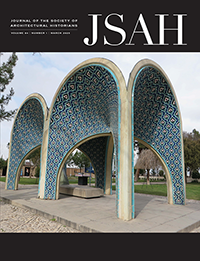First published in 1941, the Journal of the Society of Architectural Historians is a leading English-language journal on the history of the built environment. For many scholars, publishing their work in the Journal is a career goal –
but the process from submission to publication isn’t readily apparent and can seem downright overwhelming.
On July 9, 2024, JSAH Editor Alice Y. Tseng and Associate Editor Claire Zimmerman sat down with SAH members via Zoom to de-mystify the process of publishing in the Journal. They shared their editorial focus, goals for good articles, and how they
help authors ready an article for publication.
If you want to publish in JSAH, follow these six pieces of advice from Alice and Claire to prepare for a great submission and review process:
Start early and plan ahead.
The Journal is published in both print and online formats. Due to layout and print preparation requirements at the University of California Press, the content for each issue must be finalized six months before it goes into production. Add to that a healthy
timeline for peer-review, revisions, and re-submissions, and scholarly articles often take 18 months to two years from initial submission date to the finished print article.
“That timeline can feel very long, but we do everything we can to work with authors,” said Tseng.
Articles are accepted on a rolling basis for JSAH. Therefore, the editors encourage authors to submit as soon as they feel ready. “Turn in the most polished version you can, and let us take it from there,” they said.
“We can help authors develop their writing,” said Zimmerman. As for acceptance, she noted, “you won’t know until you try.”
For those who need to claim published articles on their CV, the long publication timeline for accepted articles sometimes feels like an extra barrier. In such cases, the editorial team can work with authors to generate an ‘upcoming’ citation
or document confirming acceptance of work for publication.
Be original and intentional.
JSAH aims to encompass the full breadth and depth, and the geographical, temporal, and cultural diversity of the field. It has no fixed editorial focus and editors work with a wide variety of submissions.
With the editorial door virtually wide open, strong articles will put forward original research and show deep engagement with primary sources. Whether working with a known source of knowledge or a new one, show clearly how you are pushing thinking about
built environments forward. Be clear about your methods and make your conclusions evident.
Interdisciplinary work is very welcome. Good articles can also focus on a built work (or works), placing it in a larger context or analysis. Write with the journal’s audience -- architectural historians -- in mind.
Tseng also emphasized the importance of illustrations submitted with an article: “Since I'm also an art historian, I'm very interested in your use of illustrations. I want to know why you have chosen the particular objects, illustrations, artwork,
photographs for your article. What do they show?”
It is the author’s responsibility to secure permission to publish illustrations alongside their article.
Follow the guidelines.
It may seem bureaucratic to mention, but it is essential to producing a great article and journal: follow the guidelines! (Find them in the "Submitting to JSAH" section on this page.)
Send the most polished product you can. “It makes a great impression and makes our job easier to do. It makes us want to read your work,” said Tseng.
Word count in particular is important. Scholarly articles submitted for review should aim for 8,000 words in length, with notes and captions not exceeding 4,000 additional words. Other pieces, such as book reviews, field notes, and roundtable essays
(more on these in a moment) are typically 1,500-4,000 words depending on the type.
Most often, manuscripts run long, but a scholarly article that falls far short of the recommended word count might also be in jeopardy.
“[While having fewer words] doesn’t automatically count against you, it is unusual for an author to be so succinct but also offer enough depth of detail,” Tseng said.
“We want content that changes how we think about the field. Can you do that in just 5,000 words?” Zimmerman said. “There is a longstanding length guidance for a reason.”
Review takes several months. Don’t panic.
The review process often takes longer than many people expect – not because of the quality of submitted work, but because of the challenge of finding the right people to review it.
Each JSAH scholarly article that passes a preliminary editorial review is peer-reviewed by no fewer than two experts from the same field. Established scholars with a strong published record in a paper’s subject matter are prime candidates. Reviewers
are in high demand and their time is short. While the JSAH team try their best, it can take months to confirm two reviewers and receive their reviews.
JSAH uses a double-blind peer-review process. All references to the author in the manuscript are removed, and the reviewer is not given any information about the author. This aims to avoid any bias based on whether the article comes from an advanced degree
candidate or a many-times-published academic.
Explore a variety of formats to share your ideas.
In addition to four to five scholarly articles, each issue of JSAH may also offer:
- Reviews of recent books, exhibitions, films, and other media,
- Editorials designed to place the discipline of architectural history within a larger intellectual context,
- JSAH roundtable, a series of short essays allowing a range of contributors to explore new research directions through a variety of lenses,
- Field notes linking scholars’ overarching work and research to current affairs, often in the form of an opinion article or open essay, and
- Findings that are brief accounts of specific research discoveries, reflections on research methods, or commentaries on historical questions.
The editors actively solicit content for these sections, but also welcome member pitches. They recommend reading previously published pieces as examples of focus and flow. Following your pitch, an editor will reach out for a discussion about feasibility
for developing your idea fully. These formats, except for Findings, are not peer-reviewed and are instead evaluated by JSAH’s editorial team.
“While we cannot take all ideas, we want to be sure that we are hearing from the community about issues of interest, especially if it is something that might go otherwise unreviewed,” Zimmerman said. She also noted that offering to write a
review is a great way to start a relationship with the journal.
Revise and resubmit.
The most common result of peer-review is a request to revise and resubmit. Don’t be discouraged!
“‘Revise and resubmit’ is not a final answer and it doesn’t diminish your chances of being published.” Zimmerman said. “It is a normal part of the process, and it may take a few rounds of editing to get to the final
version.”
A JSAH editor will get involved to help you understand your reviewers’ comments and develop a working relationship through rounds of edits.
Each year just 16-20 articles out of roughly 90-100 submissions will be chosen. To those not selected, Tseng hopes they will continue to consider JSAH when they have new ideas for publication.
“No matter whether you are published or not in JSAH, my goal is for everyone to come away feeling positive and that they got something out of the process,” Tseng said.
____________________
Article written by Olivia Archer based on material presented at the July 2024 Member Meetup, “Publishing in JSAH,” held July 9, 2024, on Zoom.


